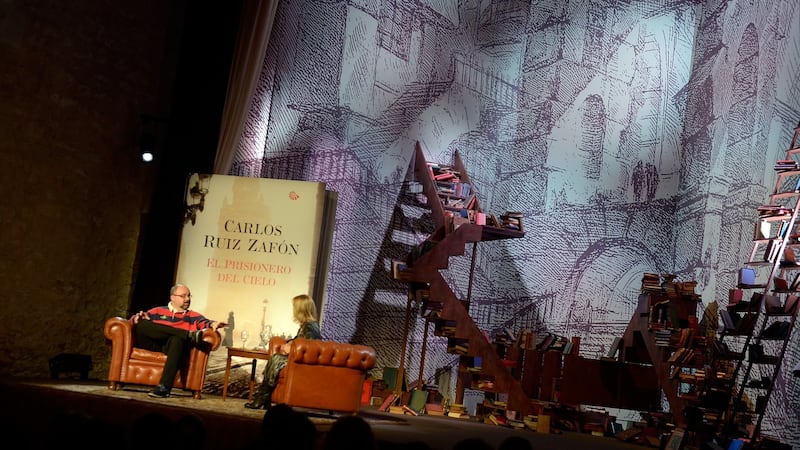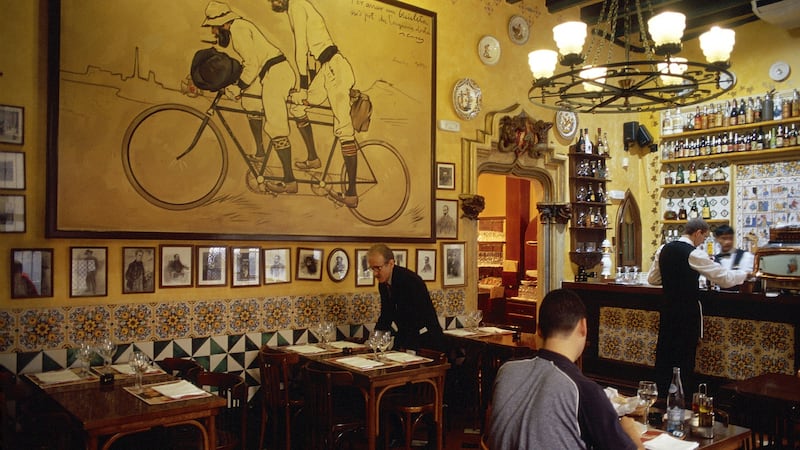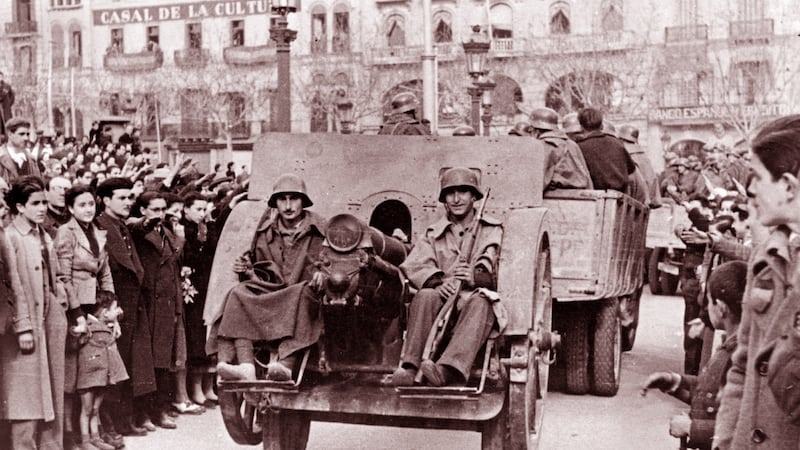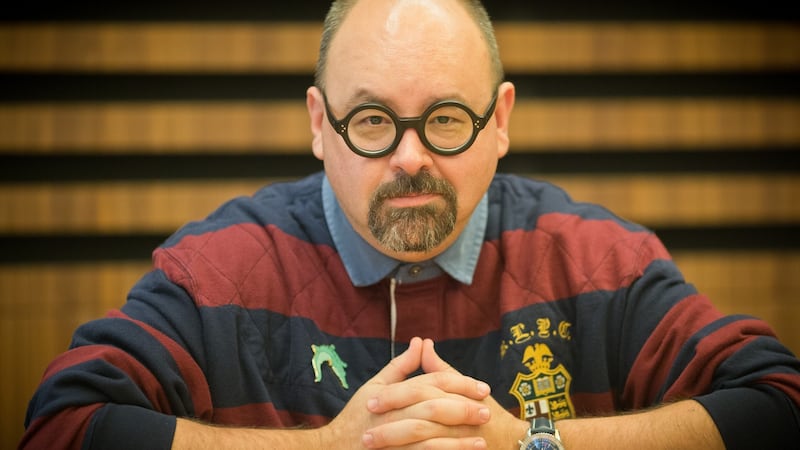The boy’s name is Daniel Sempere. It is a rainy day in the summer of 1945, and the setting is the historical neighbourhood of El Raval, a maze of dark and narrow streets in postwar Barcelona. The boy’s father, the owner of a second-hand bookshop, is taking Daniel to a secret library built on the “carcass of a palace” about which he must not breathe a word to anyone. There, the boy is introduced to the labyrinthine Cemetery of Forgotten Books, where tradition stipulates that first-timers must pick a book and make a vow to protect it from oblivion.
Fate guides Daniel's eyes towards a beautiful but very rare tome, a novel entitled The Shadow of the Wind. Unaware that this book will alter the course of his life in ways he could never have predicted, he takes it and begins to investigate the history of its ill-fated writer, the now forgotten Julián Carax.
Soon enough, a threatening figure begins to hunt down this last remaining copy. Who is the scarred man? Why is he so bent on the destruction of Carax’s books? And what can Daniel do to guard the memory of its author other than dig deeper into his dangerous past?
Thus opens the novel of the same title by Spanish writer Carlos Ruiz Zafón. This literary thriller offers chills and many a shocking revelation, as well as a romp through some of Barcelona’s most well-loved streets. More than tell a story, readers are handed the various pieces of a fictional puzzle, in the shape of conversations and diary entries, and asked to put them together in order to get the answers to the many questions opened up by Daniel’s discovery.

"This book deserves your most devoted and young ingenuity," wrote reporter Lilian Neuman in a short piece for Catalonia's leading newspaper, La Vanguardia, in June 2001. The novel had been published just over a month before by the prestigious Planeta on a print run of 4,000 copies after it was shortlisted for the Fernando Lara award. It was a modest investment for a book that showed modest promise.
Although its author, Carlos Ruiz Zafón, was no newbie to the literary scene, this was his first book for adults, and Neuman seems to have been genuinely looking to motivate her readers into giving his novel a serious chance. Little could she, Ruiz Zafón or his publishers have foreseen that The Shadow of the Wind and its two sequels – The Angel's Game (2007) and The Prisoner of Heaven (2011) – would go on to sell over 25 million books in 40 countries, making their author the most read and sold Spanish writer since Cervantes.
Bestselling lists
Although the long four to five-year gaps between volumes, as well as Ruiz Zafón’s refusal to let the stories be filmed, may have somewhat stifled their momentum, this has not stopped the books from outselling those of international writers like Dan Brown or from remaining at the top of the bestselling lists in his native Spain.
The Labyrinth of Spirits, finally coming out in English this September, is the concluding volume in The Cemetery of Forgotten Books quartet. Given Ruiz Zafón's wide readership, the new novel is likely to do well in English-speaking countries, and it will certainly make the delights of the series' fans.
Ruiz Zafón's current literary stardom may give the misleading impression that he was an overnight sensation. This was really not the case, and his success both inside and outside of Spain was instead slow and gradual. La Vanguardia aside, who continued to support and promote The Shadow of the Wind, no other newspaper or magazine gave it much time or attention upon publication. The book captured the interest of El Mundo and El País only in 2002, by which point it was already selling consistently throughout the country.

Popular magazines like the Spanish Rolling Stone turned to the book as late as 2004, after the novel had been translated into English and garnered international acclaim. The book was, in effect, one of those rare cases of a word-of-mouth bestseller – a book that made it big despite a rather silent reception and little promotion.
Genre fiction
Those who showed an interest in The Shadow of the Wind did not remark upon the novel's wartime background, choosing to focus on the writer's genre fiction leanings. This is important, since genre fiction continued, at the turn of the century, to struggle to achieve literary credit in a market where only the most scrupulous of social realisms had tended to gain critical recognition.
Scepticism was the natural reaction: could the book really be any good? And could the Spanish really write fiction worth exporting?
In retrospect, it is not hard to see why the book did so well. The novel’s clever mix of bildungsroman, detective fiction, Gothic mystery and social realism was rather unique in the sum of its parts, and it appealed to readers of noir and thrillers. Daniel’s journey with his father to The Cemetery of Forgotten Books also captures the excitement of discovering literature for the first time.
The introduction to the next generation of favourite works has an underlying procreative nature that is pleasurable for both the inquisitive child and the seasoned adult seeking to pass down what they have long treasured.
The novel also evokes in the reader a species of return to that youthful moment where fiction is magical and close to our personal world. There is indeed something supernatural about the experience, at least for Daniel, who does not so much find The Shadow of the Wind as the book finds him.
Ruiz Zafón's love for literature was also evident from his reliance on imported models. He drew from the lengthy urban novels of Dickens; from the polyvocal narratives of Wilkie Collins and Bram Stoker; from the effects and seclusion of the Gothic, especially of Gaston Leroux's The Phantom of the Opera. Trying to capture The Shadow of the Wind's heady intertextual, metafictional and referential mesh, The Washington Post described it as "Gabriel García Márquez meets Umberto Eco meets Jorge Luis Borges for a sprawling magic show, exasperatingly tricky and mostly wonderful".
If nothing else, this suggests why the novel did well abroad. In its smart rehashing of foreign formulas, it became eminently intelligible to audiences who may not be familiar with the political context or the characters’ sometimes very Spanish humour.
Barcelona novel
Also crucial to the commercial potential of The Shadow of the Wind was its capacity to become the quintessential Barcelona novel. Other urban metropolises already have their own: Dublin has Ulysses; New York has The Bonfire of the Vanities; London has many, among them those of Zadie Smith. Barcelona, up until Ruiz Zafón, had Eduardo Mendoza's La ciudad de los prodigios (The City of Marvels, 1986), which had focused on the city's bourgeois ascent at the turn of the last century and had provided a rather scathing portrayal of its nouveau riche as unfeeling creatures driven by money and power.
Mendoza's hybrid of brainy satire and scrupulous historical fiction would never have appealed to the average tourist on the Gaudí-Las Ramblas-harbour tour. By contrast, The Shadow of the Wind has it all: the book is a highly appealing potboiler; it provides readers with some light historical context about the Civil War, and paints it as an old and secret-laden place whose key locales may still be visited in the present day.
The mixture of iconic landmarks (Santa Maria cathedral or the Quatre Gats café), off-the-beaten-path streets (Santa Anna street or the Baixada de la Llibreteria) and inventions (the Cemetery of Forgotten Books) was a winning formula that would return in all the other novels in the series. Despite of Ruiz Zafón’s portrayal of the city as depressed and rainy, the novel’s acute sense of place was eminently bankable, and the tourist industry did not take long to catch up.
The Shadow of the Wind walking book tour, purporting to take readers through the locations in the novel, still exists today and remains extremely popular (link below).
City’s image
The disjuncture between the sunny, artistic and cosmopolitan image of Barcelona found in the contemporary tourist industry and Ruiz Zafón's intrinsically depressed Barcelona is worth dwelling on further. For if The Cemetery of Forgotten Books series is to be redeemed as more than enthusiastically referential entertainment with an eye to Barcelona's appeal as a tourist destination, then this needs to happen via a careful evaluation of its setting and time.
The decision to set the events of the postwar (and in later books of the war itself) against the fallen and oppressed capital of Catalonia is as political as anything else to come from the "memory boom" of the turn of the century. Although The Shadow of the Wind was never as explicit about the silences of the Spanish Civil War as, say, the work of Manuel Rivas or of Javier Cercas, this powerful aspect of Ruiz Zafón's novels has remained largely overlooked outside of academia.
The novel has had, and still has, an immense role to play in enabling a reassessment of Barcelona that turns away from Mendoza’s cold critique of its capitalist renaissance towards a more modern take attuned to the city’s views regarding the legacy of Franco and the centralist struggles that led to, among other things, clashes with the police in the boycotted independence referendum vote of 2017.
Journalist Sergio Vila-Sanjuán, the first to ever write about The Shadow of the Wind in the press, captured this idea beautifully when he wrote, upon finishing the book, that he found himself "looking at the city with new eyes, dazed by its violently Gothic recasting of avenues and buildings which had, up until yesterday, appeared to transmit an unshakeable sense of bourgeois placidity".
Let me be clear, Ruiz Zafón's aim was not to recreate faithfully early 20th-century Barcelona. This much is obvious from the many references in his writing to sensational novels. The Civil War was not the main subject of the first two books in The Cemetery of Forgotten Books either, but rather a backdrop of destruction, loss and fear that echoes the mood of the city and of its characters. After all, Daniel's tale is the typical coming of age story, hinging as it does on the acceptance that life and the world are cruelly unfair and require legitimate sacrifices. And yet, like a ghost or cursed Gothic legacy, the war haunts and pervades all events. Police officer Fumero, an irredeemable murderer and mercenary, turns out to be the real monster in The Shadow of the Wind, not the apparently resuscitated Carax.

Andrea Corelli's mysterious request to ghost-writer David in The Angel's Game that he help him write a tract for a new religion which may facilitate social control appears to be a shorthand for the ideological narrative imposed by Franco's dictatorship. Unsurprisingly, the book is set just on the brink of the Civil War. And it is difficult not to think of the Cemetery of Forgotten Books as a metaphor for the war's dead.
The place is described as an “endless necropolis” where volumes “remain unexplored, forgotten forever” until rescued by a daring reader who may become their protector. It doesn’t require a huge leap of imagination to conceive of these readers as modern, 21st century Spaniards in need of speaking about, and preserving the rights of, their dead.
Take, for example, the zeal with which mass war graves have been dug up in the 21st century, especially following the introduction of the Historical Memory Law by the socialist party in 2007, which extended rights to those who were the victims of persecution or violence during the war and Franco’s dictatorship. With the exhumation of the remains of Franco himself having been approved this August, it seems that Spain is finally coming to a tipping point regarding the legacy of silence left behind by the Civil War. The younger generations, affected by the war in less direct but equally lasting ways, seem ready to unearth the past, both physically and politically.
War’s trauma
It is interesting to trace this awakening to the trauma of the Civil War, to its gaps and omissions, in Ruiz Zafón's books. For if the first two novels only skirted around the Civil War, The Prisoner of Heaven and The Labyrinth of Spirits have been much more heavy-handed and specific in their respective treatments of the subject.

The Prisoner of Heaven follows the misadventures of Fermín, Daniel's close friend, upon being apprehended by the regime in 1939, as well as his escape from Montjuïc castle, a symbolic fortress associated with the Catalan defeat to Spain in 1714 and which was turned into a prison during the Civil War. Lluís Companys, president of the Generalitat of Catalonia, was killed there in 1940.
Similarly, one of the most horrific scenes in the novel involves a nightmare where Fermín sees “a bottomless mass grave strewn with corpses […], the flood of ghostly bodies stirring like an eddy of eels. The dead bodies opened their eyes and climbed the walls, following him.”
The horrors here are those of the war; the spectral and the real cold bloodied hands.
The Labyrinth of Spirits opens with another escape scene, this time set in Barcelona's harbour during the 1938 nationalist bombings that reduced large parts of the city to rubble. The bottom of the sea is seething with "dozens of handcuffed corpses" that form a macabre "submarine cemetery". It is a haunting picture for a narrative that often presents the past as a matter of bare survival, which is, in fact, how the war has often been described by its survivors.
Moral codes
One of the main themes of The Prisoner of Heaven is precisely how the crimes of the war were measured according to different moral codes from those used before and after it. But should they, Ruiz Zafón's novels seem to ask, or should we always strive for a modicum of humanity?
Until recently, Spain has seemed reluctant to answer this question, much in the same way that it has resisted the sanctioning of the crimes committed during the war or the repealing, against the recommendation of the United Nations, of the amnesty law established by the Pact of Forgetting. Whether deliberately or otherwise, many critics of The Cemetery of Forgotten Books series have distanced themselves from the novels' commentaries on the Civil War and its legacy. Instead, reviewers have torturously returned to ossified debates on style or the literary merits of the bestseller.

With The Labyrinth of Spirits, the various imbricated stories begun 17 years ago come together, and the book cycle finally draws to a close. The spirits of the Spanish Civil War, on the other hand, remain particularly restless. I am certain there will be many more literary attempts to articulate the silences and shadows of the Spanish past, and the Gothic and mystery modes – with their interests in what lies beneath, repressed or unacknowledged – will continue to make perfect fictional negotiators. Whether these new works will be as enjoyable and complex as Ruiz Zafón's series remains to be seen.
Dr Xavier Aldana Reyes is senior lecturer in English Literature and Film at Manchester Metropolitan University, and the author of Spanish Gothic (2017).
The Labyrinth of Spirits is out on September 18th: iti.ms/2N1LmVv
The Shadow of the Wind Walking Book Tour: iti.ms/2xFjuS6


















